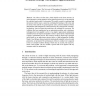Free Online Productivity Tools
i2Speak
i2Symbol
i2OCR
iTex2Img
iWeb2Print
iWeb2Shot
i2Type
iPdf2Split
iPdf2Merge
i2Bopomofo
i2Arabic
i2Style
i2Image
i2PDF
iLatex2Rtf
Sci2ools
GECCO
2004
Springer
2004
Springer
Validating a Model of Colon Colouration Using an Evolution Strategy with Adaptive Approximations
The colour of colon tissue, which depends on the tissue structure, its optical properties, and the quantities of the pigments present in it, can be predicted by a physics-based model of colouration. The model, created by analysing light interaction with the tissue, is aimed at correlating the histology of the colon and its colours. This could be of a great diagnostic value, as the development of tissue abnormalities and malignancies is characterised by the rearrangement of underlying histology. Once developed, the model has to be validated for correctness. The validation has been implemented as an optimisation problem, and evolutionary techniques have been applied to solve it. An adaptive approximate optimisation method has been developed and applied in order to speed up the computationally expensive optimisation process. This works by iteratively improving a surrogate model based on an approximate physical theory of light propagation (Kubelka Munk). Good fittings, obtained under the ...
| Added | 01 Jul 2010 |
| Updated | 01 Jul 2010 |
| Type | Conference |
| Year | 2004 |
| Where | GECCO |
| Authors | Dzena Hidovic, Jonathan E. Rowe |
Comments (0)

